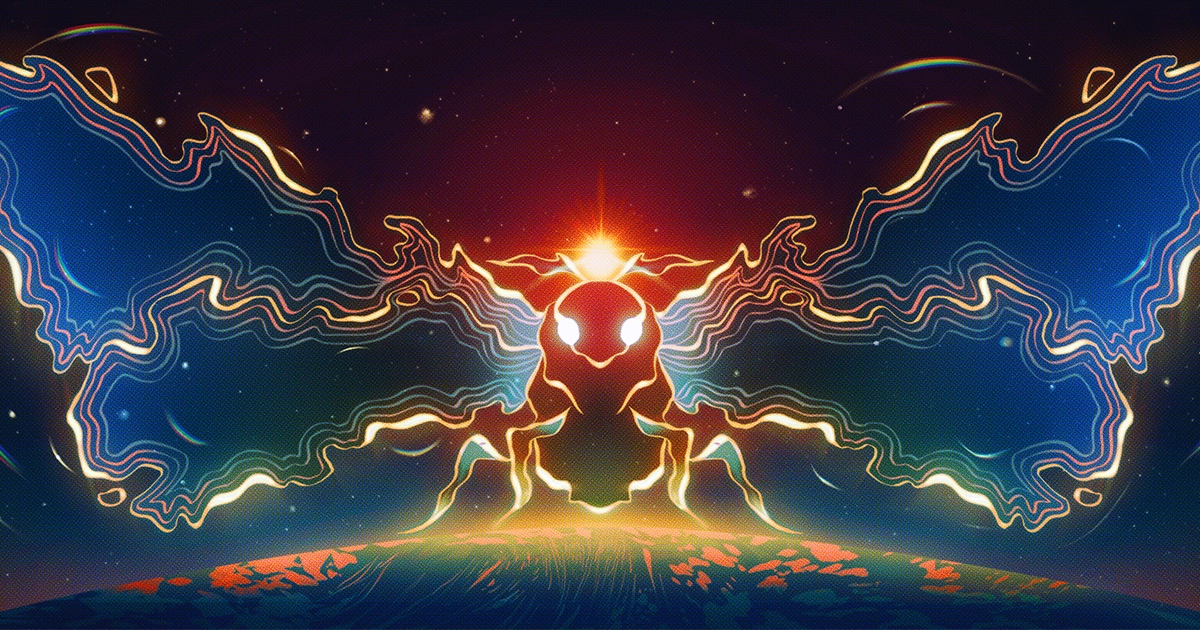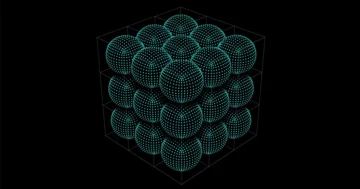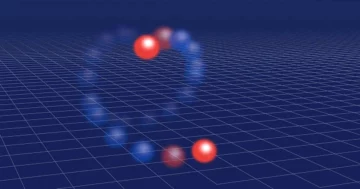
Introduction
Last October, as the James Webb Space Telescope beamed down its first long exposures of the sky near the constellation Eridanus, astronomers began to piece together the story of a dim, flickering point of light that seemed to emerge from the deepest recesses of the universe.
Whatever it was, it glimmered for too long to be a supernova; a single star, too, was off the table. “It feels like you’re probably in one of these CSI movies, that you’re a detective,” said José María Diego, an astrophysicist at the Institute of Physics of Cantabria in Spain who worked to decipher the signal. “You have a lot of suspects on the table, and you have to eliminate [them] one by one.”
Diego and his colleagues recently reported that the faint smudge of light appears to come from an extreme star system they nicknamed Mothra — a pair of supergiant stars that, in their heyday, a full 10 billion years ago, outshone nearly everything else in their galaxy.
At that time, the entire universe was younger than the Earth is now; our planet only started to coalesce after the Mothra photons had reached the halfway mark in their cosmic journey to a world that would develop a giant infrared-sensitive space telescope just in time to catch their light. Detecting light emitted by individual star systems that long ago used to be impossible. But Mothra, named after a kaiju monster inspired by silk moths, is just the latest in a recent string of oldest-ever, farthest-ever, just generally superlative star systems astronomers have found in images from JWST and the Hubble Space Telescope. And in a twist, while Mothra and its beastly brethren are intriguing astrophysical objects in their own right, what excites Diego the most is that the monster stars’ light seems to reveal a very different class of object floating between it and Earth: an otherwise invisible clod of dark matter that he and his colleagues calculated weighs between 10,000 and 2.5 million times the mass of the sun.
If such an object really exists — a preliminary conclusion for now — it could help physicists narrow down their theories about dark matter and maybe, just maybe, solve the mystery of the universe’s unexplained mass.
As of 2023, laboratory efforts to trawl for individual dark matter particles have come up empty, leaving some astrophysicists with the grimly pragmatic suspicion that the only way humans can put calipers on the mysterious substance might be to study its gravitational effects on the wider universe. So Diego’s team and others are searching for the ghostly outlines of dark objects in the cosmos. They hope to identify the smallest clumps of dark matter that exist — which in turn depends on the basic physics of the dark matter particle itself. But lumps of pure dark matter don’t just present themselves to astronomers; teams use observational tricks to coax such shadows from shadows. Now astronomers are focusing on cosmic phenomena ranging from space-warping gravitational lenses — the kind of invisible, dark matter-dominated magnifying glass that revealed Mothra — to fluttering, ribbonlike streams of stars much closer to home. So far, these efforts have ruled out many variants of a popular set of models called “warm dark matter.”
“You can’t touch dark matter,” said Anna Nierenberg, an astrophysicist at the University of California, Merced who is searching for dark interstellar blobs with JWST. But finding small structures made of it? “That’s as close as you would get.”
Halo, Halo, Halo
What little we know about dark matter exists in vague, blurry outlines. Decades’ worth of evidence has suggested that either theories of gravity are incomplete, or, as astrophysicists more commonly argue, a dark matter particle haunts the universe. In one classic observation, stars seemed to race around the outskirts of galaxies as if held in a far stronger gravitational grip than visible matter would suggest. By measuring the motions of these stars and applying other techniques that identify regions of space with extra heft, astronomers can visualize how the universe’s dark matter is distributed on larger scales.
“If we had dark matter goggles,” Nierenberg said, around every galaxy we would probably see “a big, fuzzy, extended, watermelon-shaped structure that’s much larger than the galaxy itself.” For our own Milky Way, astronomers estimate that this diffuse, dark cocoon — termed a halo — weighs roughly a trillion solar masses and is more than 10 times wider than the galaxy’s spiral disk of stars.
Zoom in to smaller scales, though, and scientific certainty breaks down. Is the Milky Way’s dark matter halo a smooth schmear? Or is it arranged in clumps, called sub-halos? And if so, what sizes are those clumps?
The answers could allow scientists to identify dark matter’s true nature. Models of how the universe evolved its current structure — a cosmic web, woven by pearlescent strings of galaxies — predict that dark matter particles, whatever they are, gathered into small, gravitationally bound clumps during the first few hundred thousand years after the Big Bang. Many of those clumps merged and eventually pulled in visible matter. Those grew into the seeds of galaxies. But some of the smallest dark halos that didn’t merge should still exist as “remnants of structure formation in the early universe,” said Ethan Nadler, an astrophysicist at the Carnegie Observatories and the University of Southern California. “Kind of like a time machine.”
Introduction
Finding and weighing these relic clumps would help physicists tighten their hold on the basic physics of dark matter — including the mysterious particle’s mass and its “temperature,” a somewhat misleading term that describes the speed at which clouds of individual particles zip around.
One of the leading suspects in the dark matter mystery is cold dark matter, a class of models in which the culprits are relatively heavy and sluggish particles; one example is a weakly interacting massive particle, or WIMP. If these theories are right, such particles would have easily settled into self-gravitating clumps in the early universe, some of which might have been as small as an Earth mass. Today, these lingering mini-halos of dark matter should still be adrift within and around the larger collective halo of galaxies like the Milky Way.
But if lighter dark matter particles whisked through the early cosmos faster, as a competing class of “warm” dark matter models suggest, only larger clumps with a heftier gravitational pull could have formed. These models suggest that there’s a cutoff for dark matter structures, a minimum mass beneath which halos don’t exist. So whenever someone discovers a new, smallest-known dark halo (like the purported one between Earth and Mothra), theorists are forced to rule out progressively cooler scenarios.
Another popular class of models, called fuzzy dark matter, assumes just a whisper of a dark matter particle — perhaps 1028 times lighter than an electron. Hypothetical particles called axions, for example, could be in this size range and also relatively cold. These featherweights would behave more like waves than particles, rippling across galaxies. Like warm dark matter, this wavelike incarnation wouldn’t form gravitationally bound clumps on mass scales smaller than galaxies. But ultralight dark matter would have another tell. As waves of fuzzy dark matter lap against each other within a halo, they might form smaller interference patterns called granules — grainy-looking regions where the dark matter density is higher — that would impart their own measurable gravitational signature.
Ruling out some of these theories requires finding — or conspicuously not finding — dark matter halos with lower and lower mass. The search started by identifying the most diminutive halos known to swaddle dwarf galaxies, dark matter clumps that still weigh hundreds of millions of solar masses, and it is now working its way into the unknown. The problem, though, is that these hypothetical small dark halos probably lack the gravitational heft needed to attract regular matter and ignite stars. They can’t be seen directly — they’re little more than heavy shadows. “The hunt has been on for evidence,” said Matthew Walker, an astrophysicist at Carnegie Mellon University. “It’s just hard to find.”
Lessons From Lenses
Today’s most advanced searches for small, dark sub-halos piggyback on an almost miraculous phenomenon: gravitational lensing. Predicted by Einstein, gravitational lenses are regions of warped space-time surrounding a massive object. That object’s gravitational field — the lens — distorts and focuses background light in much the same way that a magnifying glass can enlarge the image of an ant or concentrate sunlight enough to light a fire.
Each lensing alignment involves a light source shining from the far shores of the universe, and the lens itself. Often, these lenses are massive galaxies or galaxy clusters that warp space-time and happen to be aligned, by cosmic chance, between that distant source and Earth. Lenses produce a range of optical effects, from arcs of light to multiple copies of the same background source to highly magnified images of objects that would otherwise be much too far away to see.
It was only by fishing through the lensed cosmos that, in 2017, astronomers photographed Icarus, a star that burned bright some 9 billion years ago. More recently, they found the almost 13-billion-year-old Earendel, the current record holder for the most ancient star, which sheds as much light by itself as 1 million suns. They also spotted Godzilla, a monstrously energetic distant star undergoing an explosive outburst, and Godzilla’s fellow monster Mothra, which seems to be a similar type of variable object. (“And yes, we are having fun with this,” Diego said of his team’s naming process.)
But gravitational lenses aren’t just portals to the other side of the universe. Dark matter hunters have long considered the lenses at least as interesting as what they magnify. The precise ways in which the lens warps and distorts the background image correspond to how mass is distributed in and around the lensing galaxy or cluster. If dark matter exists in small starless clumps within the known pattern of galaxy-size halos — well, then, astronomers should be able to see light bending around those clumps, too.
The smallest dark halos detected through this method already rival the smallest halos measured around dwarf galaxies. In 2020, a team including Nierenberg used the Hubble Space Telescope and the Keck Observatory in Hawai‘i to look at magnified images of quasars — blazing beacons of light emitted by matter falling into black holes — and found evidence for dark halos as small as hundreds of millions of solar masses. That’s the same rough halo size associated with the smallest galaxies, a level of statistical agreement that Nadler, in a study published the following year, used to rule out warm dark matter models made up of particles lighter than about 1/50 of an electron, in which such diminutive clumps could never form.
This year, meanwhile, two teams used lensed quasars to look for grains of fuzzy, featherweight dark matter particles — grains that would form through a process similar to the one that makes ripples appear on the surface of a swimming pool, according to the first author of one of these studies, Devon Powell of the Max Planck Institute for Astrophysics. “You get this very chaotic, lumpy distribution of the matter,” he said. “It’s just wave interference.”
Introduction
His team’s analysis, published in June in Monthly Notices of the Royal Astronomical Society, did not find evidence for wavelike dark matter effects in high-resolution images of arcs of light from one gravitational lens, suggesting that the dark particle must be heavier than the smallest fuzzy candidates. But an April study in Nature Astronomy, led by Alfred Amruth of the University of Hong Kong, looked at four lensed copies of a background quasar and came to the opposite conclusion: A lens made of fuzzy dark matter, they argued, better explained small fluctuations in their data. (Contradictory findings wouldn’t be entirely surprising given that the expected signals are subtle and the experimental approach is new, experts outside both teams tell Quanta.)
Nierenberg and her colleagues, meanwhile, have spent the last year using JWST to observe gravitational lenses that magnify quasars, with the tentative goal of publishing their first analysis in September. In theory, they calculate that JWST’s ability to uncover small-scale structure in lenses should reveal whether dark halos exist as fully invisible, starless clumps with a size range of tens of millions of solar masses. If so, those halos would impose the strongest constraint yet on how “warm” dark matter can be.
This even newer method of looking at extreme, faraway stars like Mothra through gravitational lenses might soon move from identifying one-off curiosities to becoming a regular feature of astronomy in the JWST era. If Diego and his colleagues are correct, and they can see Mothra because it’s being lensed by a dark matter clump weighing fewer than a few million solar masses, that observation alone would rule out a wide swath of warm dark matter models. But it would still support both cold and fuzzy dark matter, although in the latter case — where the extra magnification of Mothra comes from a dense granule of dark matter instead of a gravitationally bound clump — it would still force fuzzy dark matter into a narrow range of possible masses.
Astronomers are unearthing many more lensed stars with Hubble and JWST, Diego said, keeping an eye out for other anomalous optical distortions that could come from starlight bending around small dark objects. “We’re just starting to scratch the surface,” he said. “I don’t take much vacation these days.”
Dark Islands in a Stream of Stars
Other searches for small dark matter halos are focused on much closer stars — those in streamers near the Milky Way, and binary stars in nearby dwarf galaxies. In 2018, Ana Bonaca, now an astrophysicist at the Carnegie Observatories, raced to download data from the European Space Agency’s Gaia spacecraft, which measures the motions of nearly 2 billion stars in the Milky Way. Bonaca sorted through those initial observations and isolated the information from stars belonging to a structure called GD-1. What she saw was “immediately super exciting,” she said. “We rushed to write a paper in the next week or so.”
GD-1 is a stellar stream, a loose string of Milky Way stars that — if you could pick it out with the naked eye — would stretch more than halfway across the night sky. These stars were ejected from a globular star cluster long ago; they now orbit the Milky Way on either side of that cluster, bobbing behind and ahead of its path like buoys marking an interstellar channel.
In their analysis of GD-1, Bonaca’s team found the theoretical fingerprint of an interloping hunk of dark matter. Specifically, part of GD-1 seemed split in two as if a massive invisible object had blundered through the trail, pulling stars in its wake. That passing object, they calculated, may have been a dark matter sub-halo weighing a few million solar masses — making it, too, a contender for the smallest putative dark matter clump, and a potential threat to the toastier variants of warm dark matter.
But how to convert a single finding to something more statistical? By now, Bonaca said, astronomers have chronicled about 100 stellar streams. While only a handful have been studied in detail, each one that has been scrutinized has its own unusual kinks and bends that may come from gravitational encounters with similarly small, dark objects. But the observations aren’t conclusive yet.
“I think the best way forward is to analyze streams simultaneously,” she said, “to understand how much of [those unusual features] is coming from dark matter.”
On even smaller scales, Walker, at Carnegie Mellon, has spent the last year scanning JWST observations of dwarf galaxies in search of the most fragile star systems he can find: binary stars that are very far apart and held together in a loose gravitational embrace. If small dark halos — the sorts of objects that cold dark matter models say should be plentiful — are continually passing by and exerting gravitational pulls on their surroundings, these very wide binaries shouldn’t exist. But if wide binaries do show up, that suggests small dark halos aren’t present — striking a body blow against the many cold dark matter models that predict them.
“It’s what I call an anti-search for subgalactic dark matter halos,” Walker said.
Moving in the Walls
The search for cosmic shadows is still a small part of a larger effort to pin down something that has so far squirmed out of reach. Earth-based experiments designed to trap particles that would fit the fuzzy, warm and cold dark matter paradigms crank on; teams are still looking for other hallmarks of dark matter physics, from side products produced if and when the particles interact with normal matter, to the subtle question of how dark matter’s density rises and falls within dark halos, which depends on how the dark particles interact with each other.
Tracy Slatyer, a theoretical physicist at the Massachusetts Institute of Technology, visualizes the dark matter mystery as a vast box full of myriad possibilities but holding only one right answer. In this analogy, her strategy is to slice deep into that box with specific, disprovable ideas about the properties of dark matter particles. The sides of the box, though, represent the only true confining facts astronomers can provide, such as upper limits on how warm dark matter can be, and lower limits on how fuzzy — or lightweight — it can be.
If astronomers could confidently detect fully dark cosmic objects in the million-solar-mass range, that would be an “observational tour de force,” Slatyer said. “It would be incredible.” The walls of her box would move inward, shrinking the space available for possibilities.
Upcoming technology may soon transform these various searches from early stabs in the dark into deeper forays into the shadowy structures that undergird the universe. JWST will deepen its study of gravitational lenses in the coming years; Nierenberg’s group, for example, has started with eight such systems but plans to eventually analyze 31 of them. When it launches in 2027, the Nancy Grace Roman Space Telescope, a Hubble-grade observatory with a much wider field of view, should make it much easier to pan through dwarf galaxies as Walker is doing. The Vera C. Rubin Observatory, named for the pioneering astronomer whose observations forced researchers to take the mystery of dark matter seriously in the first place, will reveal more details of stellar streams once it starts observing from Chile in 2024. Together, the two observatories should turn up thousands of new gravitational lenses that can be scoured for dark substructures.
So far, none of the observations have toppled the popular cold dark matter models, which predict that the universe is littered with smaller and smaller clumps of the stuff. As astronomers continue the grueling work of combing for those clumps, many theorists and experimentalists hope that a particle physics experiment on Earth will cut to the heart of the mystery much faster. But uncovering these isolated pockets of darkness — and any intricate physics that accompanies them — is like “getting a cleaner laboratory,” Slatyer said. “We’re at an exciting time.”
- SEO Powered Content & PR Distribution. Get Amplified Today.
- PlatoData.Network Vertical Generative Ai. Empower Yourself. Access Here.
- PlatoAiStream. Web3 Intelligence. Knowledge Amplified. Access Here.
- PlatoESG. Automotive / EVs, Carbon, CleanTech, Energy, Environment, Solar, Waste Management. Access Here.
- PlatoHealth. Biotech and Clinical Trials Intelligence. Access Here.
- ChartPrime. Elevate your Trading Game with ChartPrime. Access Here.
- BlockOffsets. Modernizing Environmental Offset Ownership. Access Here.
- Source: https://www.quantamagazine.org/in-a-monster-stars-light-a-hint-of-darkness-20230829/
- :has
- :is
- :not
- :where
- ][p
- $UP
- 000
- 1
- 10
- 100
- 2017
- 2018
- 2020
- 2023
- 2024
- 31
- 9
- a
- ability
- Able
- About
- According
- across
- advanced
- After
- against
- ago
- Agreement
- ahead
- aligned
- allow
- alone
- already
- also
- Although
- an
- analysis
- analyze
- Ancient
- and
- Another
- answer
- answers
- ant
- any
- apart
- appear
- Applying
- approach
- April
- ARE
- argue
- argued
- around
- arranged
- AS
- associated
- assumes
- astronomy
- astrophysics
- At
- attract
- author
- available
- away
- background
- basic
- BE
- because
- becoming
- been
- began
- behave
- behind
- being
- BEST
- between
- Big
- Big Bang
- Billion
- Black
- black holes
- BLAZING
- blow
- body
- both
- bound
- Box
- breaks
- Bright
- burned
- but
- by
- calculate
- calculated
- california
- call
- called
- came
- CAN
- candidates
- Carnegie Mellon
- Carnegie mellon university
- case
- Catch
- certainty
- Chance
- Channel
- Chile
- class
- classic
- cleaner
- Close
- closer
- Cluster
- CMU
- coalesce
- cold
- colleagues
- Collective
- come
- comes
- coming
- coming years
- commonly
- competing
- concentrate
- conclusion
- confidently
- considered
- continually
- continue
- convert
- copies
- correct
- Cosmos
- could
- CSI
- Current
- Cut
- Dark
- Dark matter
- data
- Days
- de
- Decipher
- deep
- Deepen
- deeper
- deepest
- dense
- density
- depends
- designed
- detail
- details
- detect
- detected
- develop
- DID
- Diego
- different
- directly
- Discovers
- Distant
- distributed
- distribution
- do
- doing
- Dont
- down
- download
- during
- each
- Early
- Early Universe
- earth
- easier
- easily
- effects
- effort
- efforts
- eight
- einstein
- either
- eliminate
- else
- embrace
- emerge
- enlarge
- enough
- Entire
- entirely
- Era
- estimate
- European
- Even
- eventually
- Every
- everything
- evidence
- evolved
- example
- excites
- exciting
- exist
- exists
- expected
- experiment
- experimental
- experiments
- experts
- extra
- extreme
- eye
- facts
- faint
- Falling
- Falls
- far
- faster
- Feature
- Features
- fellow
- few
- fewer
- field
- Find
- finding
- findings
- fingerprint
- Fire
- First
- Fishing
- fit
- floating
- fluctuations
- focused
- focuses
- focusing
- following
- For
- Force
- forced
- form
- formation
- formed
- Forward
- found
- four
- from
- full
- fully
- fun
- Galaxies
- Galaxy
- gathered
- generally
- get
- giant
- given
- glass
- goal
- grace
- gravitational
- gravity
- grew
- Group
- had
- halfway
- handful
- happen
- Hard
- Have
- having
- he
- Heart
- heavy
- Held
- help
- her
- high-resolution
- higher
- highly
- his
- hold
- holder
- holding
- Holes
- Home
- Hong
- Hong Kong
- hope
- How
- How To
- HTML
- HTTPS
- Hubble
- Hubble Space Telescope
- Humans
- hundred
- Hundreds
- hundreds of millions
- hunt
- i
- ideas
- identify
- identifying
- if
- Ignite
- image
- images
- impose
- impossible
- in
- Including
- incredible
- individual
- information
- initial
- inspired
- instead
- Institute
- interact
- interacting
- interesting
- Interstellar
- into
- intriguing
- involves
- Islands
- isolated
- IT
- ITS
- itself
- james
- James Webb Space Telescope
- journey
- june
- just
- keeping
- Kind
- Know
- known
- Kong
- laboratory
- Lack
- larger
- Last
- Last Year
- latest
- launches
- leading
- least
- leaving
- Led
- Lens
- lenses
- Level
- light
- lighter
- lightweight
- like
- limits
- little
- Long
- Look
- looked
- looking
- Lot
- lower
- machine
- made
- magazine
- make
- MAKES
- Making
- many
- mark
- marking
- Mass
- massachusetts
- Massachusetts Institute of technology
- masses
- massive
- Matter
- max
- May..
- maybe
- Meanwhile
- measured
- measures
- measuring
- Mellon
- Merge
- method
- might
- Milky way
- million
- millions
- minimum
- misleading
- MIT
- models
- more
- most
- motions
- move
- Movies
- much
- multiple
- must
- myriad
- mysterious
- Mystery
- Named
- naming
- narrow
- Nasa
- Nature
- Near
- nearly
- needed
- never
- New
- newer
- next
- next week
- night
- None
- normal
- now
- object
- objects
- observations
- observatory
- observe
- observing
- october
- of
- off
- often
- on
- once
- ONE
- only
- opposite
- optical
- or
- Orbit
- Other
- Others
- otherwise
- our
- out
- outlines
- outside
- own
- pair
- PAN
- Paper
- part
- particle
- Passing
- path
- Pattern
- patterns
- perhaps
- phenomenon
- Photons
- Physics
- pick
- piece
- PIN
- Pioneering
- Place
- planet
- plans
- plato
- Plato Data Intelligence
- PlatoData
- pockets
- Point
- pool
- Popular
- possibilities
- possible
- potential
- pragmatic
- precise
- predict
- predicted
- present
- probably
- Problem
- process
- produce
- Produced
- Products
- progressively
- properties
- provide
- published
- Publishing
- pulling
- Pulls
- put
- Quasar
- question
- Race
- range
- ranging
- reach
- reached
- really
- recent
- recently
- record
- regions
- regular
- relatively
- Reported
- represent
- requires
- researchers
- reveal
- Revealed
- right
- ripples
- rippling
- Rises
- Rival
- roughly
- royal
- Rule
- ruled
- Said
- same
- saw
- say
- scales
- scanning
- scenarios
- scientific
- scientists
- scratch
- Search
- searching
- see
- seeds
- seemed
- seems
- seen
- September
- seriously
- set
- Settled
- she
- should
- show
- side
- Sides
- Signal
- signals
- signature
- silk
- similar
- Similarly
- simultaneously
- single
- Size
- sizes
- sky
- Slice
- sluggish
- small
- smaller
- smallest
- smooth
- So
- so Far
- solar
- SOLVE
- some
- Someone
- something
- somewhat
- Soon
- Source
- Southern
- Space
- space telescope
- spacecraft
- Spain
- specific
- specifically
- speed
- spent
- split
- stabs
- Star
- Stars
- started
- Starting
- starts
- statistical
- Stellar
- Still
- Story
- Strategy
- stream
- streams
- String
- stronger
- structure
- structures
- studied
- studies
- Study
- substance
- such
- suggest
- Suggests
- Sun
- sunlight
- Super
- supernova
- support
- Surface
- surprising
- Surrounding
- swimming
- Systems
- table
- Take
- team
- teams
- techniques
- Technology
- telescope
- tell
- tens
- term
- than
- that
- The
- the information
- their
- Them
- themselves
- then
- theoretical
- theory
- These
- they
- Think
- this
- those
- though?
- thousand
- thousands
- threat
- Through
- tighten
- time
- times
- to
- today
- together
- too
- touch
- Tour
- trail
- Transform
- tricks
- Trillion
- true
- TURN
- twist
- two
- type
- uncover
- understand
- Universe
- university
- University of California
- University of Southern California
- unknown
- unusual
- use
- used
- using
- vacation
- variable
- various
- Vast
- very
- View
- visible
- visualize
- Wake
- walker
- warm
- was
- Wave
- waves
- Way..
- ways
- we
- web
- webp
- week
- weigh
- weighing
- weighs
- WELL
- were
- What
- whatever
- when
- whenever
- whether
- which
- while
- Whisper
- WHO
- whose
- wide
- wider
- will
- with
- within
- Work
- worked
- working
- world
- worth
- would
- write
- year
- years
- yes
- yet
- you
- Younger
- zephyrnet
- Zip











